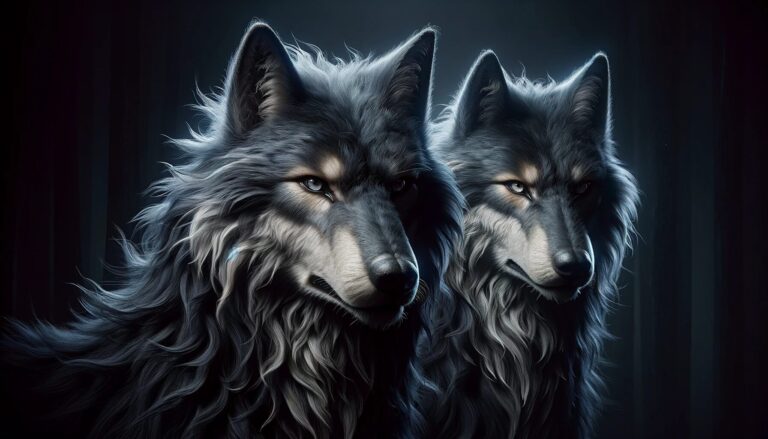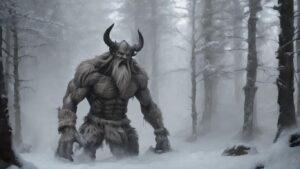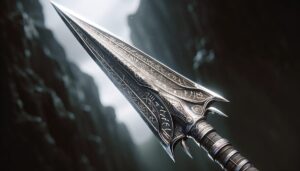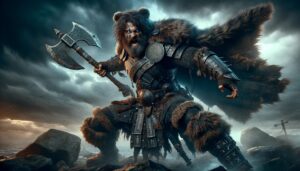Table of Contents
In the grand tapestry of Norse mythology, where gods, giants, and creatures of all kinds intermingle, two figures stand out as the constant companions of the Allfather, Odin himself. Geri and Freki, not typical mythical beings with wings or scales, hold a special place in Viking mythology. Geri and Freki are, in fact, wolves, but their significance goes far beyond their appearance.
Origins and Family
Geri and Freki’s origins trace back to early Norse mythology. They are offspring of the giantess Angrboða and Loki, making them half-siblings to Fenrir and Jörmungandr. Often called the “Wolves of Odin” or the “Wolves of War,” they have a significant lineage.
The parentage of Geri and Freki ties them to some of the most enigmatic and powerful beings in Norse mythology, highlighting their connection to the chaotic and unpredictable forces of the world. While their kin, Fenrir and Jörmungandr, represent impending doom and destruction in the Ragnarök prophecy, Geri and Freki serve a different purpose in the pantheon of Norse gods.
Appearance
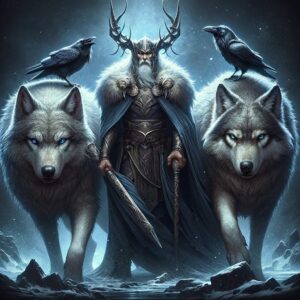
Various ancient texts and artistic representations describe their appearances. A detailed portrayal follows:
Coat Color and Texture: They often describe Geri and Freki with sleek, lustrous fur in shades of gray, silver, or white, lending them a regal, divine aura.The fur of these wolves is smooth and well-groomed, reflecting their connection to the highest of the Norse gods, Odin.
Size and Build: These wolves are depicted as larger and more imposing than ordinary wolves. They possess a strong and muscular build, emphasizing their strength and power. Their size is symbolic of their significance in Norse mythology and their role as guardians and companions to Odin.
Eyes: Their eyes possess an intense, piercing gaze, hinting at ancient wisdom and divine knowledge. Sometimes, they’re portrayed with an otherworldly glow, symbolizing their connection to Odin, the god of wisdom and war.
Expression: The expressions of Geri and Freki are typically portrayed as solemn and regal. They exude an air of dignity and loyalty, mirroring their role as the constant companions of the Allfather. Their demeanor conveys a sense of reverence and devotion in the presence of Odin.
Abilities
While they share physical traits with wolves, their abilities go beyond the natural characteristics of their species. Here are the abilities commonly associated with Geri and Freki:
Divine Companionship: Geri and Freki’s most significant ability is their divine connection to Odin, the Allfather of the Norse gods. They are chosen by Odin to be his constant companions and serve as symbols of his wisdom and authority. Their ability to exist in the presence of the highest deity in Norse mythology highlights their special status.
Understanding and Communication: These wolves possess a unique capacity to understand and communicate with Odin. They are not ordinary wolves in this regard; instead, they share a deep, spiritual bond with the god. While they do not engage in verbal communication as humans do, they convey their thoughts, feelings, and insights to Odin through a form of telepathic or intuitive connection. This ability allows Odin to seek their counsel and wisdom.
Guardianship: Geri and Freki serve as loyal guardians to Odin, both in times of peace and during moments of conflict. Their presence is a source of protection and comfort to the Allfather. They are seen as the protectors of his sacred hall, Valhalla, and are known to accompany him on his travels through the realms of Norse cosmology.
Weakness
While Geri and Freki are powerful and formidable beings, they are not invincible. In Norse mythology, no creature, god, or entity is immune to the inexorable forces of fate and destiny. Ragnarök, the cataclysmic event, holds Odin’s destined end. Geri and Freki’s loyalty to Odin can also be perceived as a potential weakness. Their unwavering devotion to the Allfather might make them vulnerable to manipulation by those who seek to harm Odin or disrupt the balance of the cosmos.
Behavior with Humans
Geri and Freki’s interactions with humans in Norse mythology are limited, as they primarily serve as Odin’s constant companions. However, their presence in the mythos carries a profound message about the relationship between humans and the divine in Norse culture.
As loyal companions to Odin, Geri and Freki embody the idea of loyalty, companionship, and the importance of forming deep bonds with both human and non-human entities. Their presence serves as a reminder that even the most powerful and enigmatic of gods value the company and devotion of their companions.
Symbols Representing Them
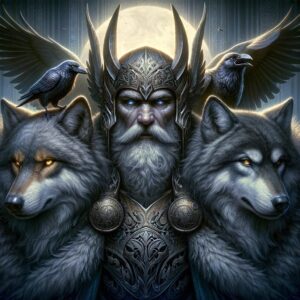
While Geri and Freki lack frequent physical symbols, they occasionally appear with Odin in various forms of artistic expression. In such portrayals, they symbolically represent Odin’s wisdom and authority.
In a broader sense, wolves themselves hold a significant place in Norse symbolism. They are associated with attributes such as cunning, strength, and the untamed aspects of nature. As Odin’s companions, Geri and Freki also symbolize the connection between the divine and the wild, bridging the gap between the human world and the mysterious realms of the gods.
Related Myths and Stories
While Geri and Freki are not central figures in many Norse myths, their appearances in various texts and sagas highlight their enduring presence in the cultural tapestry of the Vikings. Here are a few notable instances where they make appearances:
Grímnismál
In the ancient Norse poem “Grímnismál,” Odin, the chief of the Norse gods, provides a detailed account of his many names and aspects during a conversation with the human king Geirröd. This poetic exchange sheds light on the multifaceted nature of Odin’s identity and underscores the significance of his loyal companions, Geri and Freki.
In this captivating poem, Odin reveals himself under various aliases, unveiling the diverse roles he fulfills in the cosmos. Simultaneously, as he discloses his numerous names, he highlights his wisdom and authority as the Allfather. Moreover, Odin’s names mirror his connections to war, knowledge, poetry, magic, and other domains, thereby significantly underscoring his crucial role in Norse mythology.
Moreover, among the names Odin mentions are Geri and Freki, signifying their importance in the grand scheme of Norse mythology. These names underscore their role as companions to Odin, showcasing their presence and significance in his divine entourage. The inclusion of Geri and Freki among Odin’s many names reinforces their position as guardians and confidants to the chief of the gods.
The poem “Grímnismál” not only offers a glimpse into Odin’s multifaceted identity but also highlights the depth of Norse mythology and its intricate portrayal of the divine. Through this poetic exchange, readers gain insight into the rich tapestry of beliefs and traditions woven into the stories of the Norse gods, where even the names of Odin’s loyal wolves carry profound meaning and significance.
Hávamál
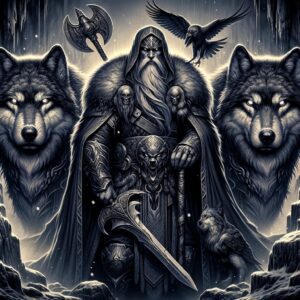
In the collection of Old Norse poems known as the “Hávamál,” attributed to Odin, there is a fascinating tale involving Odin’s wolf companions, Geri and Freki. This narrative not only sheds light on the cunning and enigmatic nature of Odin but also reveals his willingness to employ his companions in unconventional ways.
Within the “Hávamál,” Odin embarks on a riddle contest with the wise giant Vafþrúðnir. This contest represents a battle of wits, where each participant strives to outsmart the other. Odin, renowned for his wisdom and insatiable thirst for knowledge, is resolute in his mission to showcase his intellectual prowess.
During the contest, Odin poses a riddle to Vafþrúðnir, asking him to answer a question about the gods. In this riddle, Odin references his own wolf companions, Geri and Freki, in a rather cryptic manner. He states that they consume the meat of fallen warriors, alluding to their role in feasting upon the brave souls who have perished in battle.
This reference to Geri and Freki in the riddle serves a dual purpose. On one hand, it underscores the ferocious and formidable nature of these wolf companions, as they partake in the consumption of warriors’ remains. On the other hand, it challenges Vafþrúðnir to decipher the deeper meaning behind the metaphor, testing the giant’s knowledge and wit.
The riddle involving Geri and Freki showcases Odin’s cleverness in using symbolism and metaphor to convey his messages. It also underscores the importance of these wolves in Norse mythology, as they are not only loyal companions to the Allfather but also bearers of symbolic significance that transcends their physical existence.
Ragnarök
In Norse mythology, which revolves around Ragnarök, the apocalyptic event marking the world’s end, foretells a significant role for Geri and Freki, Odin’s loyal wolf companions. Their involvement contributes to the cataclysmic chaos and destruction that will reshape the cosmos.
During Ragnarök, Geri and Freki, along with their half-sibling Fenrir, take part in the final battle. Fenrir, a monstrous wolf, breaks free from his bindings, leading an army of giants and beings. In this dire hour, Geri and Freki align with Fenrir, intensifying the forces of chaos.
The involvement of Geri and Freki in this cosmic battle is symbolic of their ties to the unpredictable and uncontrollable aspects of the natural world. As wolves, they embody the untamed forces of nature and the wilderness. In Ragnarök, they fully embrace their primal and destructive instincts.
Furthermore, their allegiance to Fenrir and their participation in the battle against the gods, including Odin himself, underscores the inevitability of Ragnarök and the cyclical nature of life and death in Norse mythology. The wolves’ role in the chaos of the end times reminds us that destiny can sweep even the most loyal and revered companions into the world’s ultimate reshaping.
In essence, Geri and Freki’s participation in Ragnarök signifies their transformation from steadfast protectors and confidants of Odin into agents of destruction, embodying the turbulent and transformative forces that accompany the end of one world and the beginning of another in the complex tapestry of Norse mythology.
Snorri Sturluson’s Prose Edda
Snorri Sturluson’s “Prose Edda,” a 13th-century compilation of Norse myths and legends, briefly mentions and vividly describes Geri and Freki, Odin’s wolf companions. This description offers additional insight into their role within Norse mythology.
The passage characterizes Geri and Freki as “greedy for the flesh of those doomed to die,” shedding light on their connection to the fate of fallen warriors. Moreover, this portrayal underscores their link to the concept of death and the afterlife in Norse mythology. It suggests that these wolves have a particular affinity for the fallen warriors who have met their fate in battle.
The phrase “doomed to die” implies a sense of inevitability and fate, aligning with the Norse belief in predestined events. Additionally, it relates to the concept of Valhalla, Odin’s hall of fallen heroes. Odin chooses warriors who die honorably in battle, taking them to Valhalla, where they feast and fight, preparing for Ragnarök.
Geri and Freki’s eagerness for the flesh of these fallen warriors reflects their role in the divine order. They are not merely scavengers but rather active participants in the process of ushering these heroic souls into Odin’s hall, where they will prepare for the final battle of Ragnarök.
This description also underscores the symbiotic relationship between the wolves and the honored warriors, as the fallen heroes provide sustenance for Geri and Freki, while the wolves, in turn, ensure the warriors’ journey to the afterlife in Valhalla.
Other Creatures
Fenrir (Norse Mythology): Monstrous wolf and half-sibling of Geri and Freki, destined for a destructive role in Ragnarök.
Werewolves (Various Folklore): Humans with the ability to transform into wolves, linked to the duality of human and animal nature.
Lycanthropes (Greek and Roman Mythology): Shape-shifters into wolf-like beings, associated with wolf symbolism.
Skoll and Hati (Norse Mythology): Celestial wolves chasing the sun and moon, linked to cosmic events.
Warg (Norse and Fantasy Literature): Large and malevolent wolves often depicted in fantasy settings.
FAQ
What do Geri and Freki names mean?
Geri and Freki's names roughly translate to "Ravenous" or "Greedy" in Old Norse, reflecting their association with feasting on the fallen in battle.
Do Geri and Freki have special abilities?
They possess a deep connection to Odin, communicate with him intuitively, and participate in the events leading up to Ragnarök, the Norse apocalypse.
What is their role in Ragnarök?
In Ragnarök, they align with their half-sibling Fenrir, contributing to the chaos and destruction that reshapes the world.
How Geri and Freki look like?
They are typically described with sleek, lustrous fur in shades of gray, silver, or white, often possessing an intense and piercing gaze.
